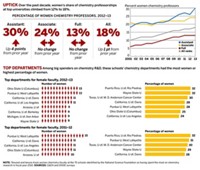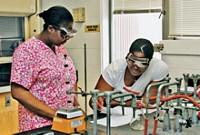Advertisement
Grab your lab coat. Let's get started
Welcome!
Welcome!
Create an account below to get 6 C&EN articles per month, receive newsletters and more - all free.
It seems this is your first time logging in online. Please enter the following information to continue.
As an ACS member you automatically get access to this site. All we need is few more details to create your reading experience.
Not you? Sign in with a different account.
Not you? Sign in with a different account.
ERROR 1
ERROR 1
ERROR 2
ERROR 2
ERROR 2
ERROR 2
ERROR 2
Password and Confirm password must match.
If you have an ACS member number, please enter it here so we can link this account to your membership. (optional)
ERROR 2
ACS values your privacy. By submitting your information, you are gaining access to C&EN and subscribing to our weekly newsletter. We use the information you provide to make your reading experience better, and we will never sell your data to third party members.
Alternative sources for recruiting
A letter in C&EN by Shashi Gupta is just one of the many pieces on diversity in the science news press (Oct. 25, 2004, page 11). Gupta's letter made the point that the recent slowing of the flow of graduate students to the U.S. from foreign countries signals an impending decline in U.S. science. Science and the New York Times recently published similar concerns. In these comments, the only remedy considered is intensifying foreign student recruitment. We suggest a view not considered in these articles.
Foreign scientists bring one form of diversity to our students and scientific workforce, and we have been quite successful in achieving this diversity. In 2002, a large proportion of science graduate students were from overseas--engineering (49%), computer sciences (48%), physical sciences (40%), and mathematical sciences (39%) (National Science Foundation data). A 2003 survey of faculty at the top 50 chemistry departments showed that about 30% of faculty hired since 1991 were from overseas (Nelson Diversity Surveys).
However, diversity is also provided by U.S. women and U.S. minorities. In 2002, the representation of U.S. women among all science graduate students was 32%, as compared to 36% U.S. men and 32% foreign nationals (NSF data). The representation of U.S. minorities was Asian 6%, black 5%, Hispanic 4%, and Native American 0.4%. The 2003 faculty survey revealed that 17% of the chemistry faculty hired since 1991 were U.S. women, 2% were U.S. underrepresented minority (URM) men, 1% U.S. URM women, 4% U.S. Asian men, and 2% U.S. Asian women. Thus, the recruitment of foreign chemistry faculty (30%) has been more successful than that of U.S. women, U.S. URMs, and U.S. Asians combined (23%). Moreover, very few of the foreign faculty were women; most were white or Asian men.
A particularly striking demonstration of our success in recruiting foreign scientists is in postdocs: 42% are U.S. citizens or permanent residents, and 58% are foreign nationals. More of our science postdocs are foreign than are native-born.
The data lead us to ask: Is this the balance we want to reflect the diversity in our U.S. population? Some Ph.D., M.D., and postdoc programs now largely involve foreign students. Perhaps efforts currently directed toward increasing visas for foreign science students should be refocused on identifying the barriers and disincentives facing U.S. students, particularly women and URMs. Is the problem that U.S. students do not wish to study science or medicine in numbers sufficient to fill all the slots in our graduate and medical schools, or are there barriers and disincentives for them?
Are foreign students willing to work harder than U.S. students? Are foreign students intellectually superior or do they merely perform better on some tests (for whatever reason)? Do we mentor foreign students better than we do U.S. women and underrepresented minorities?
Graduate students are more plentiful when U.S. hiring falls off, but prolonged unemployment causes U.S. students to avoid graduate school. Do we bridge these periods by further increasing foreign student numbers, making U.S. jobs less available for U.S. scientists when jobs again pick up?
Are greater numbers of women a possible source of scientists? Are more URMs? There are examples of successful science programs that provide model environments and attract undergraduate minorities (the Meyerhoff Program at the University of Maryland, Baltimore County), graduate minorities (Louisiana State University, Baton Rouge, department of chemistry), and female faculty (Rutgers' department of chemistry). Perhaps more attention should be focused on emulating such programs.
E. Ann Nalley, ACS president-elect
Lawton, Okla.
Donna J. Nelson
Norman, Okla.
William A. Pryor
Baton Rouge, La.
Isiah M. Warner
Baton Rouge, La.
ATTENTION READERS
A letter to all American Chemical Society members bringing them up-to-date on the status of ACS's discussions with the National Institutes of Health on the database known as PubChem is available on chemistry.org.





Join the conversation
Contact the reporter
Submit a Letter to the Editor for publication
Engage with us on Twitter